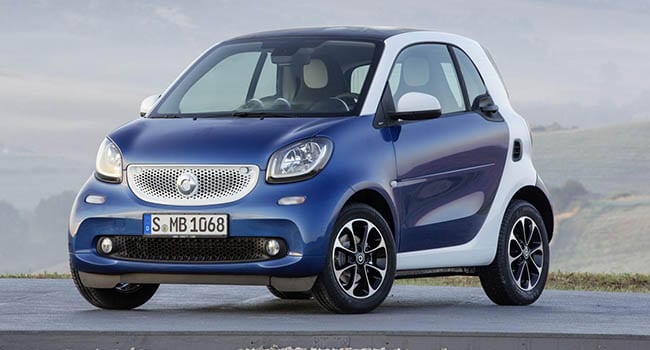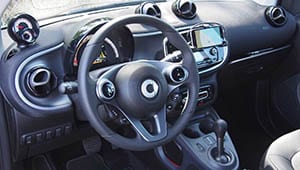
The Smart is homely, undersized and really bad in the snow. But it’s arguably the best city car, pound for pound, money can buy. Best of all, perhaps, it’s remained relatively unchanged over the years (shown is the 2016 model year, which received a modest restyling) and, for those in the market for a thrifty used car runabout, it’s cheap like borscht
 When the Mercedes-Benz Smart car debuted in Canada in 2004, I had mixed feelings, to put it mildly.
When the Mercedes-Benz Smart car debuted in Canada in 2004, I had mixed feelings, to put it mildly.
At first, I absolutely loathed it, mainly because the first versions were really ugly and it had a clunky, uneven diesel drivetrain that just wouldn’t behave.
Things got better with the introduction of a gasoline engine model a few years later. But there was no getting around the fact that the Smart was tiny, had virtually no storage and got no respect from other, bigger automobiles.
But it persevered.
Now, with Car2Go shutting down its operations in Canada and Mercedes discontinuing the Smart after the 2020 model year, this thrifty, surprisingly durable city runabout may be in short supply.
Homely, undersized and really bad in the snow, it’s arguably the best city car, pound for pound, money can buy. Best of all, perhaps, it’s remained relatively unchanged over the years and, for those in the market for a thrifty used car runabout, it’s cheap like borscht.
Arguably its biggest virtue is that it’s incredibly nimble and manoeuvrable around the city. It also delivers excellent fuel economy and can be parked almost anywhere. With almost 90 horsepower on tap (depending on the year), it’s fun to drive. And as long as you don’t look behind you, it doesn’t feel like one of the smallest automobiles ever to plant a tire on Canadian roads.
In 2016, it got a modest restyling job. And the three-cylinder engine was bumped up to 898 cc, developing 89 horsepower at 5,500 rpm, with an ample 100-foot-pounds of torque at 2,500 rpm. Transmission choices are a five-speed manual or six-speed automatic – the smart money chooses the former.

As the 2016 Smart shows, ergonomics and switchgear are straightforward. The radio actually has rotary dials, the heater features an easy-to-understand sliding control and there are no byzantine, illegible switches to confuse and confound. Mercedes should adopt some of this switchgear on its other offerings
Typical combined fuel economy for the Smart is around 6.9 litres/100 km and the gas-engine model prefers premium fuel. If you have the nerve, you can get a top speed of just under 160 km/h out of it and it will accelerate from zero to 100 km/h in about 11 seconds.
Because of its tiny stature, it feels like it’s going much faster than it really is, much like some old British roadsters. And it has about as much storage: 350 litres, depending upon the model. This is one vehicle you shouldn’t take to Costco.
Thanks to oversize doors that make up most of the body shell, getting in and out is easy. The Smart is accessible and driveable, and simple to get along with.
It’s not half bad on the highway either, all things considered. There’s a bit more wind/road noise than most cars, and crosswinds from passing trucks and buses can be a little disconcerting. But for the most part, it’s stable and linear, with more than enough reserve power.
And unlike many of Mercedes’ models, ergonomics and switchgear are straightforward and easy to understand. The radio actually has rotary dials, the heater features an easy-to-understand sliding control and, aside from a rather cluttered steering wheel cluster, there are no byzantine, illegible switches to confuse and confound. I wish Mercedes would adopt some of this switchgear on its other offerings.
There is one little bit of weirdness. When you release the front hood, it doesn’t tilt up and out of the way like virtually every car on the planet. The entire piece comes right off the car. It’s anchored by a couple of straps and kind of complicates routine maintenance, such as refilling the windshield washer.
Nonetheless, the Smart has its charms. Just get in and go – no fuss, no waiting for various systems to sort themselves out and no performing contortions to get behind the wheel.
The drivetrain can be a little on the stroppy side but as a cheap runabout, it has few equals.
Ted Laturnus writes for Troy Media’s Driver Seat Associate website. An automotive journalist since 1976, he has been named Canadian Automotive Journalist of the Year twice and is past-president of the Automotive Journalists Association of Canada (AJAC).
The views, opinions and positions expressed by columnists and contributors are the author’s alone. They do not inherently or expressly reflect the views, opinions and/or positions of our publication.

